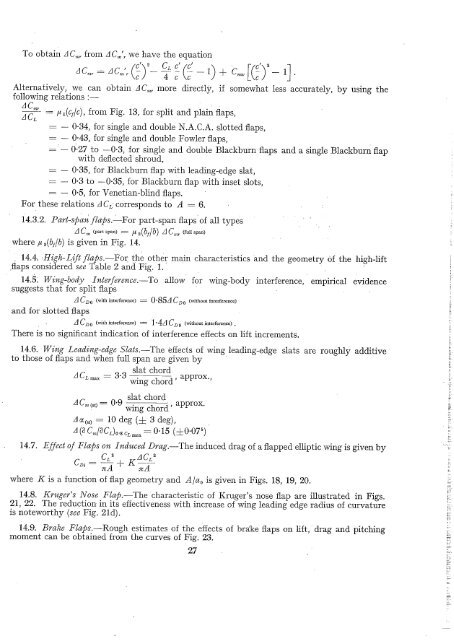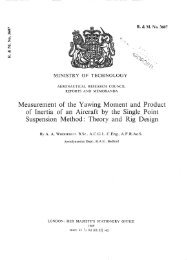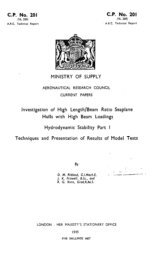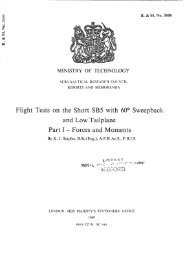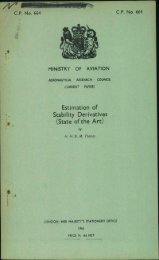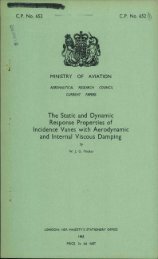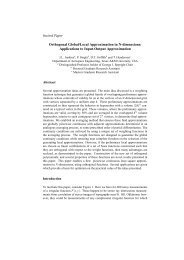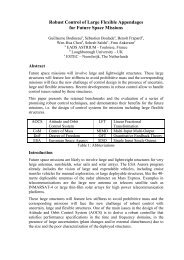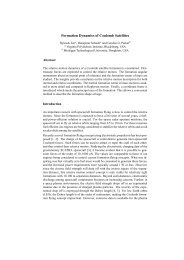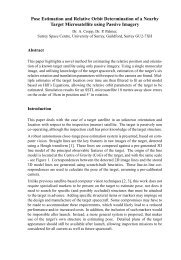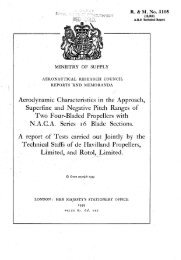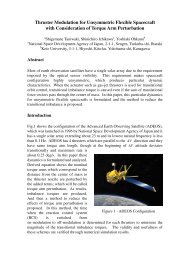The Aerodynamic Characteristics of Flaps
The Aerodynamic Characteristics of Flaps
The Aerodynamic Characteristics of Flaps
Create successful ePaper yourself
Turn your PDF publications into a flip-book with our unique Google optimized e-Paper software.
To obtain A C .... from A C,/, we have the equation<br />
= -1 +'C,,~ ~ 7 ~-1<br />
AC,,,~ AC,.',. 4 c<br />
Alternatively, we can obtain A C .... more directly, if somewhat less accurately, by using the<br />
following relations :--<br />
A C,,r<br />
Z CL -- ff l(ci/c), from Fig. 13, for split and plain flaps,<br />
= -- 0.34, for single and double N.A.C.A. slotted flaps,<br />
= -- 0.43, for single and double Fowler flaps,<br />
0.27 to --0.3, for single and double Blackburn flaps and a single Blackburn flap<br />
with deflected shroud,<br />
= -- 0.35, for Blackburn flap with leading-edge slat,<br />
= -- 0.3 to --0.35, for Blackburn flap with inset slots,<br />
= -- 0.5, for Venetian-blind flaps.<br />
For these relations A CL corresponds to A = 6.<br />
i4.3.2. Part-@an flaps.--For part-span flaps <strong>of</strong> all types ' '<br />
C m (part span) : /2 2(bf/b) A C,,r (full span)<br />
where ff 2(b/b) is given in Fig. 14.<br />
14.4. :HighcLift flaps.--Foi; the other main characteristics and the geometry Of the high-lift<br />
flaps considered see Table 2 and Fig. 1.<br />
14.5: Wing-body Interference.--To<br />
suggests that for split flaps<br />
allow for wing-body interference, empirical evidence<br />
/] CDO (with interference) = 0"854 CDO (without interference)<br />
and for slotted flaps<br />
A CDo (with interference) : I "4Z] CDO (without interference) .<br />
<strong>The</strong>re is no significant indication <strong>of</strong> interference effects on lift increments.<br />
14.6. Wing Leading-edge Slats.--<strong>The</strong> effects <strong>of</strong> wing leading-edge slats are roughly additive<br />
to those <strong>of</strong> flaps and when full span are given by<br />
slat chord<br />
ACrmax = 3"3 wing chord' approx.,<br />
A C,,, (st) = 0"9<br />
slat chord<br />
wing chord' approx.<br />
A ~(st) = 10 deg (+ 3 deg),<br />
A(~C,,,/~CL)o.8OLmax = 0"15 (+0"075)<br />
14.7. Effect <strong>of</strong> <strong>Flaps</strong> on Induced Drag.--<strong>The</strong> induced drag <strong>of</strong> a flapped elliptic wing is given by<br />
C~i Cc ~ A CL ~<br />
-- xA ~- K =A<br />
where K is a function <strong>of</strong> flap geometry and A/ao is given in Figs. 18, 19, 20.<br />
14.8. Kruger's Nose F/ap.--<strong>The</strong> characteristic <strong>of</strong> Kruger's nose flap are illustrated in Figs.<br />
21, 22. <strong>The</strong> reduction in its effectiveness with increase <strong>of</strong> wing leading edge radius <strong>of</strong> curvature<br />
is noteworthy (see Fig. 21d).<br />
14.9. Brake <strong>Flaps</strong>.--Rough estimates <strong>of</strong> the effects <strong>of</strong> brXke flaps on lift, drag and pitching<br />
moment can be obtained from the curves <strong>of</strong> Fig. 23.<br />
27


